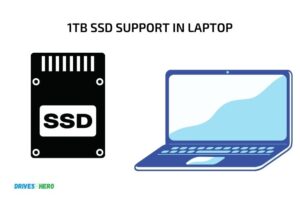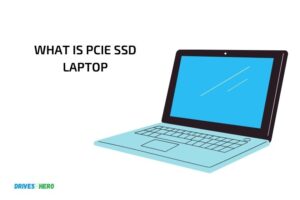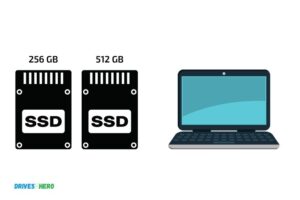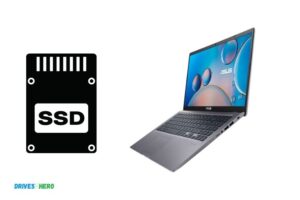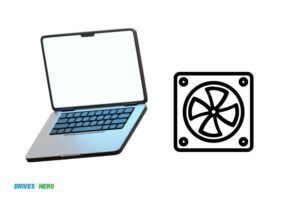Can I Add Hdd to Ssd in Laptop? Yes!
Yes, you can add an HDD to a laptop with an SSD, provided your laptop has an extra slot or a compatible drive bay to accommodate the additional hard drive.
Laptops with an SSD typically have faster boot times and application loading times due to the non-volatile NAND-based flash memory used in SSDs. However, SSDs can be expensive when considering storage capacity.
Adding an HDD to your laptop can help increase storage space without breaking the bank. It’s essential to check your laptop’s compatibility and available slots or bays before attempting to add an HDD.
To add an HDD to your laptop with an SSD, first, check the laptop’s specifications to ensure it has an available slot or drive bay.
Some laptops may have a second drive bay specifically for adding another hard drive. In other cases, you may need to replace the optical drive (DVD/CD drive) with a universal caddy or adapter to accommodate the HDD.
Ensure you have the necessary mounting hardware and follow the laptop manufacturer’s guidelines to avoid any potential damage or issues.
7 Criteria Of Add Hdd To Ssd in Laptop
| Criteria | HDD | SSD |
|---|---|---|
| Functionality | Can be added alongside an SSD in a laptop if there is enough space and an available slot | Can be added in a laptop, replacing an HDD or another SSD, if compatible |
| Capacity | Available in larger capacities up to several terabytes | Usually available in smaller capacities, up to 2TB, but more expensive per GB |
| Speed | Slower read/write speeds compared to SSDs | Faster read/write speeds, improving overall system performance |
| Power Consumption | Generally consume more power, potentially reducing battery life | Consume less power than HDDs, potentially leading to longer battery life |
| Noise | Mechanical nature may cause some noise during operation | No moving parts, resulting in silent operation |
| Durability | More prone to failure due to mechanical parts | Less prone to failure due to the absence of mechanical parts |
| Cost | Typically cheaper per GB of storage | More expensive per GB of storage, but offer faster performance |
Key Takeaway
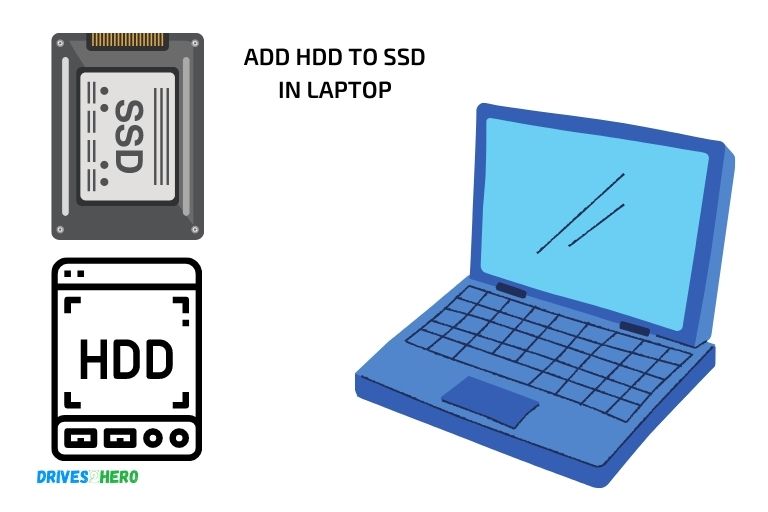
Five Facts About Add Hdd to Ssd in Laptop
Understanding Hard Disk Drives(Hdd) And Solid-State Drives(Ssd)
A hard disk drive (hdd) is a traditional storage device that uses spinning disks to read and write data. A solid-state drive (ssd) uses flash memory to store data.
Advantages And Disadvantages Of Using Each Type Of Drive
Advantages Of Hdds
- Larger storage capacity
- Lower cost per gigabyte
- Longer lifespan than ssds
Disadvantages Of Hdds
- Slower read/write speeds
- Less durable due to moving parts
- Noisier when in use
Advantages Of Ssds
- Faster read/write speeds
- More durable due to no moving parts
- Quieter when in use
Disadvantages Of Ssds
- Higher cost per gigabyte
- Shorter lifespan than hdds when used frequently
- Smaller storage capacity
The Differences Between Hdd And Ssd In Terms Of Performance, Durability, And Lifespan.
Performance
- Ssds are faster at data transfer and access compared to hdds.
- Over time, hdds slow down due to fragmentation while ssds do not face this issue.
Durability
- Hdds have moving parts and are more susceptible to damage and wear and tear.
- Ssds do not have moving parts and can withstand more physical damage.
Lifespan
- Hdds have a longer average lifespan compared to ssds.
- However, ssds have fewer failures due to the lack of moving parts.
Overall, the choice between an hdd and an ssd depends on the user’s needs. If you require a device with larger storage capacity and longer lifespan, then an hdd is a better option.
However, if you demand faster data transfer and access, higher durability, and are willing to pay more, then ssds are the way to go.
Replacing Your Laptop Hard Drive With Ssd: The How-To Guide
Looking to upgrade your laptop’s storage? Good news, you can easily swap your old hdd (hard disk drive) for a newer, faster ssd (solid-state drive).
Ssds are a popular option for their quick data access times and reliability. In this guide, we’ll walk you through step-by-step instructions for upgrading your laptop’s hard drive with an ssd.
Step-By-Step Instructions For Upgrading Your Laptop’S Hard Drive
- Start by researching and purchasing an ssd that’s compatible with your laptop.
- Before starting the installation process, make sure you have a backup of all your important data. If you need assistance in creating a backup, you can use third-party software.
- Confirm that you have the necessary tools for the installation such as a screwdriver, laptop opening tools, and an anti-static wrist strap.
- Carefully open your laptop and locate the hard drive bay. Take note of how your current hard drive is connected and secured in place.
- Disconnect and remove the old hard drive, paying attention to any cables and screws.
- Replace the hard drive with your new ssd, securing it in place with screws and reconnecting any necessary cables.
- Remember to ground yourself with the anti-static wrist strap to avoid causing damage to the new ssd.
- Close up your laptop and attach the battery once the installation is complete.
Determining Compatibility Between Your Laptop And Ssd
It’s essential to ensure compatibility between your laptop and the ssd before purchasing one. Factors to pay attention to include the type of interface, physical dimensions, and storage capacity.
Consider checking your laptop’s manual or seeking guidance from the manufacturer or reputable retailers.
Preparation: Creating A Backup And Tools Needed
Before embarking on the ssd installation process, it’s crucial to prepare by creating a backup of all your necessary data and having the necessary tools such as screwdrivers, laptop opening tools, and an anti-static wrist strap.
Installation: How To Swap Out Your Old Hdd With An Ssd
Swapping out your old hdd with an ssd involves a few essential steps including opening up your laptop, locating the hard drive bay, disconnecting and replacing the old hdd with the new ssd, and securing it in place with screws and cables.
A crucial step before installation is ensuring compatibility and creating a backup of all your necessary data.
What To Do Once The Ssd Is Installed: Formatting, Cloning, And Partitioning
After successfully installing your new ssd, a few necessary steps will guarantee that it works correctly. These steps include formatting, cloning, and partitioning.
- Formatting: This involves erasing any existing data on the new ssd and formatting it to your preferred file system.
- Cloning: You can also clone your old hard drive data to the new ssd.
- Partitioning: This involves dividing your ssd into separate storage sections to hold your operating system, apps, and files.
Using External Enclosures For Your Old Hdd
Lastly, consider using external enclosures for your old hdd once you’ve swapped it out with the new ssd. This can help you save all your files and can function as an external hard drive for your data.
Now you’re all set to upgrade your laptop’s hard drive with an ssd! With these easy-to-follow instructions, you can install and enjoy the benefits of faster data access times, reliability, and speed.
Can You Add An Hdd To Your Laptop Alongside An Ssd?
If you’re looking to improve your laptop’s storage capacity and speed, a dual-drive setup using a combination of an hdd (hard disk drive) and an ssd (solid-state drive) is a popular option.
But is it worth it? We explore the pros and cons of adding an hdd to your laptop alongside an ssd, the considerations you need to take into account, and how to maximize space and performance.
Explanation Of What Hdd And Ssd Combo Involves
Adding an hdd to your laptop alongside an ssd involves installing a secondary drive alongside your existing SSD.
The ssd acts as your operating system and program drive, while the hdd provides additional storage for larger files such as photos, videos, and games.
This combination gives you the best of both worlds – speed and storage space.
The Pros And Cons Of A Dual-Drive Setup
Before deciding whether to add an hdd to your laptop with an existing ssd, it’s essential to weigh up the pros and cons of this setup.
Pros
- Increased storage capacity: With a dual-drive setup, you get a lot more storage space than you would have with just an ssd. This extra storage is perfect for storing large files, such as videos and photos.
- Cost-effective: Compared to buying a larger ssd, adding an hdd is more cost-effective, which is particularly beneficial if you’re on a budget.
- Improved performance: By moving most of your documents and files to your hdd, you can free up space on your ssd, which can improve its performance.
Cons
- More significant risk of hardware damage: Installing a second hard drive requires you to mess with the internals of your laptop. This can put you at risk of damaging hardware.
- Reduced battery life: Depending on your hdd’s power draw, adding an hdd can reduce your laptop’s battery life, which can be a problem if you’re on the move.
Considerations For Adding An Hdd To Your Laptop With An Existing Ssd
Adding an hdd to your laptop is not as simple as buying a drive and installing it. There are a few things you need to take into account first.
- Compatibility: Make sure your laptop is compatible with an hdd and check its form factor and height to ensure that it will fit.
- Storage requirements: Consider how much storage space you need and choose an hdd with the right capacity.
- Power consumption: Choose an hdd with lower power consumption to avoid reducing your laptop’s battery life.
- Transfer speed: Consider the transfer speed of your hdd. Higher transfer speeds will mean faster loading times for your files.
How To Install An Hdd In A Laptop That Already Has An Ssd
Installing an hdd in your laptop involves opening the laptop, unscrewing the hard drive tray, and slotting the new hdd into the tray.
You’ll also need to connect the drive to the laptop’s motherboard and reinstall any software you were previously running on your computer.
If you’re unfamiliar with installing hardware, it’s always best to seek professional help.
How To Maximize Space For Both Drives And Increase Performance.
Once you’ve installed your new hdd and you’ve transferred your files, there are some things you can do to maximize the space for both drives and improve your laptop’s performance.
- Configure your programs: Change your programs’ installation directory to the hdd to keep your ssd free from bloatware.
- Move important files: Move your music, videos, and files to the hdd to free up space on your ssd.
- Use partition manager: Use a partition manager to split your hdd into different partitions, which you can use for different storage purposes.
- Enable intel smart response technology: If you have an ssd with intel smart response technology, you can use it to cache your frequently used documents and files, which ensures quick access times.
Is The Cost Worth It? Weighing Up The Benefits Of A Dual-Drive Setup Vs. A Single Drive Setup.
The cost of adding an hdd to your laptop varies, but it’s generally more affordable than buying a larger ssd.
If you require a lot of storage space, adding an hdd to your laptop is a great option. However, if you’re not a heavy user and don’t require vast amounts of storage, a single drive setup could be enough.
Ultimately, the choice depends on what you’ll be using your laptop for and your budget.
Adding an hdd to your laptop alongside an ssd can improve storage space, performance, and cost-effectiveness.
While the installation process can be tricky, if you plan carefully, it’s worth the extra effort. Just make sure to take necessary precautions to avoid damaging your hardware and consider the pros and cons before deciding on this setup.
FAQ On Can I Add Hdd To Ssd In Laptop
Can I Add An Hdd To My Laptop If It Already Has An Ssd?
Yes, you can add an hdd to your laptop with an ssd by replacing the optical drive with an hdd caddy.
Will An Hdd Slow Down My Ssd Laptop?
No, an hdd will not slow down your ssd laptop. In fact, having both an hdd and an ssd can improve overall performance.
How Do I Check If My Laptop Is Compatible With Adding An Hdd?
You can check if your laptop is compatible with adding an hdd by checking the technical specifications of your laptop model.
Can I Store Files And Programs On Both The Hdd And Ssd?
Yes, you can store files and programs on both the hdd and ssd. You just need to configure your laptop to recognize both drives.
Conclusion
Adding an hdd to an ssd in a laptop is a relatively straightforward process that can result in a significant boost in storage space and performance.
Whether you need the additional storage space for media files or want to improve your laptop’s gaming experience, this upgrade is a viable option.
However, before diving into the process, make sure to understand your laptop’s capabilities in handling both storage types, and keep in mind that backing up important data is crucial to avoid any data loss.
By following the steps and precautions outlined in this article, you can take advantage of the benefits of ssd and hdd technology and customize your laptop experience.
Whether you are a student, a professional or a casual user, adding an hdd to an ssd in your laptop can improve efficiency and productivity as you navigate today’s fast-paced digital world.


